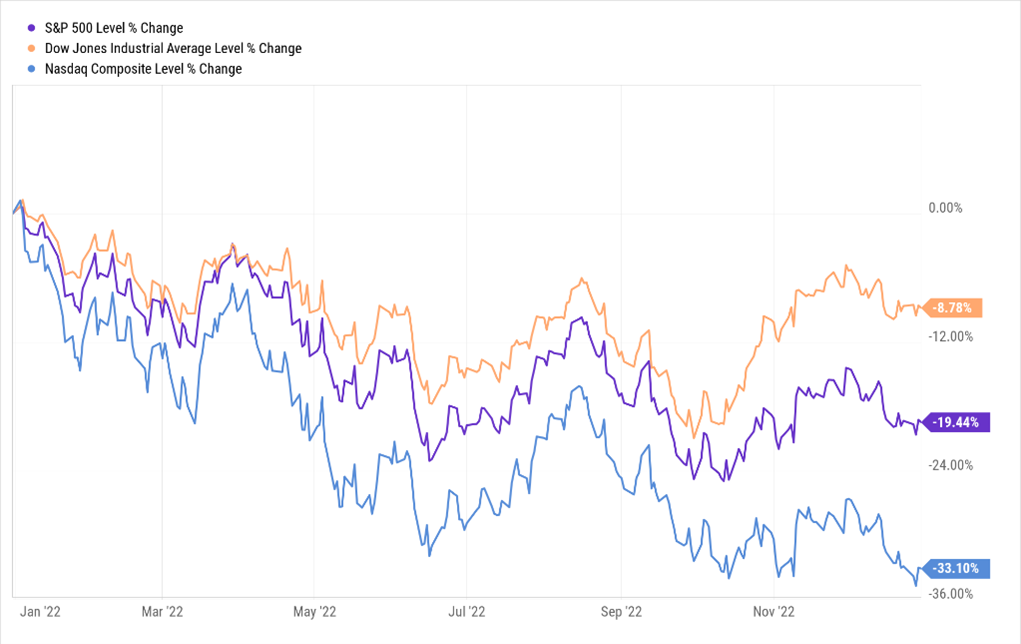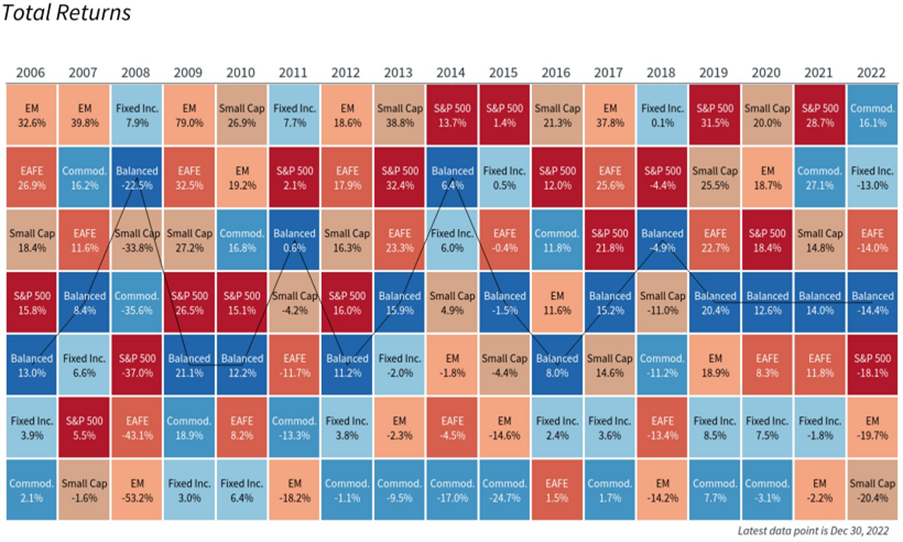
Five Things We Believe in 2023
Happy New Year! We made it. After what can only be described as a terrible, horrible, very bad year in the markets, it’s probably fair to say we’re all happy to see 2022 in the rearview mirror.
As most of you now know from experience, years like 2022 are the periodic toll we all pay for the long-term steady growth in capital markets. We will recover stronger, that we can guarantee, and wager that before the end of our careers, we’ll live through several more of these cycles together.
So, what do we expect in 2023?
In eight years, we’ve never published commentary that did not encourage you to always stay invested and keep buying…and this year is no different. We plan strategically and sleep well at night knowing that the odds lie strongly in our favor. Since 1980, the S&P 500 holds a record of 31-10-1 to the positive and has averaged a 9% annual return.
But you didn’t come all the way here just for that, so here are a five things we believe to be true today as we look ahead towards the new year:
#1 We believe the market bottomed in October of 2022
Could we be wrong? Sure. Are we in or headed for a recession? Maybe. But ultimately, we do not believe that the markets care. Broad equity markets trade downward on uncertain expectations and this past year has seen a lot of uncertainty. Just to name a few:
- Russia’s attack on Ukraine, and the immediate threat of further escalation against a NATO ally and world war;
- A global energy supply crisis caused by Russian sanctions, which sent oil prices soaring;
- Unexpectedly persistent price inflation of over 9%, even in the face of transitory supply chain easing;
- The inability to source semiconductors and other crucial inputs, coupled with a geopolitical standoff over Taiwan;
- Mid-term elections in the US;
- The UK…need we say more;
- China’s seemingly unrelenting game of ‘will they or won’t they’ in relation to the easing of Covid restrictions and economic reopening;
- And the biggest grandaddy of all – the shock of a 425% increase in interest rates and related increase in the cost of capital to the entire system.
And while there will no doubt be continued scrutiny over further aggressive Fed action, upcoming political theatre surrounding the debt ceiling over the summer, and multiple other crisis’ we can’t yet predict…the point is, from where we sit, things seem to be calming, relative to last year. A bullish sign for equities.
#2 We believe inflation has peaked
This follows broad consensus that inflation has steadily decreased from the peak of 9.1% in June. We believe that interest rate normalization coupled with supply chain easing is likely to continue to slowly push inflation back down to the Fed’s target rate of 2%; however, we do not expect to reach this level by 2023.
#3 We believe that higher interest rates are here to stay
The Fed continues to communicate that they will maintain aggressive policy action in defense against the inflation monster. But the persistent yield curve inversion signals that the market does not believe them. Market swap rates are currently pricing at a terminal rate of 4.9%, followed by rate cuts in the back half of the year. For our part, we agree that we are very near to the Fed reaching a cruising altitude of around 5%, not because they’ve achieved their goals – but because of the coming strain on the labor markets. Once that pause is reached, we expect purchase demand and inflows to bonds to increase, pushing short-term yields down and prices up. Contrary to some market pundits, we do not expect the Fed to cut rates in 2023, believing instead, that they will be willing to sacrifice a moderate weakening in the labor markets in service of the continued war on inflation.
#4 We believe in Occam’s Razor – that at least for 2023, the “simplest answer is often the right one”
By that, we mean the outperformance of high-quality stocks, investment grade bonds, and a return to fundamentals.
When you’re trying to recover from being ill, you don’t eat spicy, heavy foods that could further upset your stomach. In the same way, investors are no longer willing to indiscriminately provide bridge funding to companies or assets with high “hopes and dreams” multiples (growth companies which have not yet reached profitability). Without the ability to borrow cheaply, many of these companies are at risk because they lack the requisite free cash flow to fund continued growth through borrowing; and, in an increasingly discerning marketplace, it will be difficult to continue to secure further equity financing. This environment also does not bode well for alternative asset classes which rely heavily on leverage to deliver returns, including real estate.
We’re seeing this very clearly in the wide discrepancy in returns between US market indexes in 2022:
These three measures are all proxies for the same thing, the US large cap equity markets. The Nasdaq Composite index, which is broadly weighted towards the high growth tech sector, finished the year down -33.1%. Compare that to the Dow Jones Industrial Average, an equal weighted index of blue-chip value stocks, finished down only -8.78%. A HUGE disparity in returns across companies within the same economy. The diversified S&P 500, for which large tech companies still dominate the capitalization weighting, split the difference, finishing down -19.44%.
Finally...
#5 We believe that disciplined long-term investing that focuses on the things you can control (spending less than you earn, diversifying your portfolio, keeping costs low, being globally tax efficient, and avoiding emotional errors) over a long period of time is how to maximize return on investing.
Despite these historic shifts in the economy and markets over the past year, the principles haven’t changed. Keeping one’s footing as markets rock back-and-forth is still the best way to achieve financial goals.
The balanced portfolio in the periodic table below approximates a 60/40 stock/bond allocation. By design, it performs steadily through both good and bad markets. Given it’s impossible to predict which asset classes will outperform from year to year, diversification is a key tool to smooth out returns and maintain a disciplined approach to managing long-term portfolios.
Q4 Tactical Portfolio Actions - Back to Basics
We continue to seek opportunities to invest in high-quality companies trading at a discount after the broad market sell-off last year. During the fourth quarter, we purchased The Estee Lauder Companies, Inc. (EL) after shares declined 35% year-to-date (at time of purchase). EL manufactures and markets skin care, make up, fragrance and hair care products, including brand names such as Estee Lauder, Aramis, Clinique, Origins, M.A.C., Bobbi Brown, Le Mer and Aveda. The stock sell-off last year was due to decreased sales, largely in China, thanks to the country’s zero-Covid policy. The company was also impacted by inflationary pressures and FX headwinds.
EL’s product mix is targeted towards an affluent consumer base, which should help provide resistance against a mild recessionary environment. We also believe an easing of restrictions in China will help boost sales in that market. The trade has already paid off, with the stock posting a 6.81% return in December.
To make room in the portfolio for EL, we decided to sell our long-term stake in Nike, Inc. (NKE). We have recently become concerned around high inventory levels and significant price reductions, impacting the company’s bottom line as consumers shift buying patterns. NKE had been a portfolio holding for just over five years, and generated a return of 101% for Radix investors over that period.
We also exited our strategic position in preferred equities during the quarter, eliminating our last remaining exposure to a non-traditional asset class. Preferreds performed better than the common equity markets year-to-date (just barely!) through mid-November, due to their high dividend payout; however, as we move into the recovery, we don’t see the same opportunity on a risk-adjusted basis. Lower risk securities are now yielding on par with preferred equity dividends; thus, we have increased our allocation to fixed income to absorb the previous allocation, which has served to lower risk across all strategies, without sacrificing return.
We are strategically not invested in any alternative asset classes within our portfolio strategies at current, feeling that the opportunity for a recovery rally in the liquid equity markets, coupled with higher yields in the investment grade bond markets together present a higher potential for risk-adjusted return at a lower cost.
Final word
This week marks the eighth anniversary of Radix Financial. An incredible achievement for which we are so grateful to our clients and partners. From what started with a borrowed folding table and a white board in 2015, is now a global investment management firm. Cheers to you and cheers to us, and may 2023 end in the plus!
Yours faithfully,
Amy Hubble & Jessica Jablonowski



